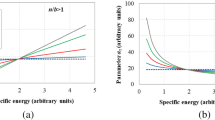Abstract
A synergetic approach based on irreversible thermodynamics is applied to the description of particle size reduction of raw materials and related technological implications.
Similar content being viewed by others
References
H. Haken, Synergetics, Springer, Heidelberg (1978).
G. F. Laptev, Elements of Vector Analysis [in Russian], Nauka, Moscow (1975).
P. Benedek and A Laszlo, Scientific Fundamentals of Chemical Technology [Russian translation], Khimiya, Moscow (1970).
I. Prigogine and R. Defay, Chemische Thermodynamik, VEB Deutscher Verlag für Grundstoffindustrie, Leipzig (1962).
I. V. Radchenko, Molecular Physics [in Russian], Nauka, Moscow (1965).
I. Prigogine, From Being to Becoming, Freeman (1980).
I. Prigogine and I. Stengers, Order out of Chaos: Man’s New Dialogue with Nature, Flamingo (1984).
G. Nikolis and I. Prigogine, Self-Organization in Non-Equilibrium Systems, Wiley (1977).
Ya. M. Bluzhdan, “The Onsager relations for chemical interactions,” Izv. Sib. Otd. Akad. Nauk SSSR, Ser. Khim. Nauk, Issue 3, No. 11, 3–11 (1966).
S. S. Voyutskii, A Course in Colloid Chemistry [in Russian], Khimiya, Moscow (1975).
D. A. Fridrikhsberg, A Course in Colloid Chemistry [in Russian], Khimiya, Leningrad (1984).
V. V. Boldyrev, “The effect of various kind of preliminary treatment on topochemical reactions,” in: Reaction Kinetics in Heterogeneous Chemical Systems (ed. P. Barret), Elsevier Sci. Publ. Co., Amsterdam (1975), pp. 589–618.
P. Glansdorff and I. Progogine, Thermodynamic Theory of Structure, Stability and Fluctuations, Wiley, London (1971).
J. Verkhash, “The Prigogine-Dyarmata principle as applied to the thermodynamics of irreversible processes,” Zh. Fiz. Khim., 40(6), 1213–1215 (1966).
É. M. Kol’tsova and L. S. Gordeev, Synergetic Methods in Chemistry and Chemistry Engineering [in Russian], Khimiya, Moscow (1999).
V. I. Bykov, N. A. Lar’kin, and G. S. Yablonskii, “The Glansdorff-Prigogine thermodynamic criterion and its application to the stability analysis of complex chemical reactions,” Zh. Fiz. Khim., 52(1), 68–70 (1978).
Author information
Authors and Affiliations
Additional information
__________
Translated from Novye Ogneupory, No. 5, May, 2005, pp. 45–51.
Rights and permissions
About this article
Cite this article
Trubnikov, I.A., Kandyusheva, E.A. A synergetic analysis of the efficiency of grinding processes. Refract Ind Ceram 46, 239–245 (2005). https://doi.org/10.1007/s11148-006-0016-y
Issue Date:
DOI: https://doi.org/10.1007/s11148-006-0016-y




